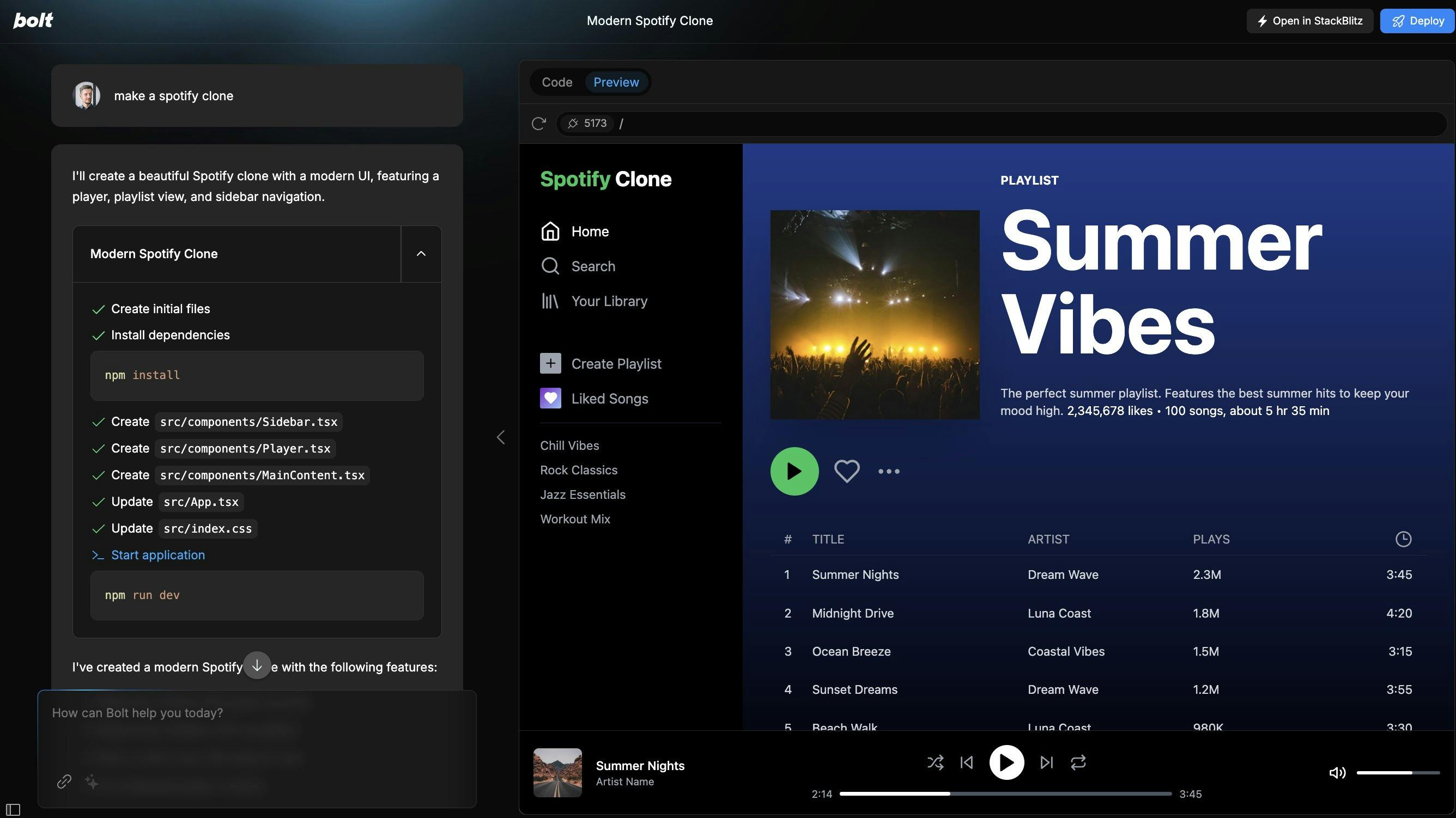
Revenue
$40.00M
2025
Funding
$7.90M
2024
Revenue
Sacra estimates Bolt.new hit $40M in annual recurring revenue (ARR) in March 2025, progressing from $4M ARR within four weeks of launch to $20M ARR in approximately two months, driven by its AI-powered web development platform.
Bolt.new's revenue model centers on a token-based pricing structure, offering a $20/month plan with 10M tokens and a free tier with 1M tokens. The platform targets two primary customer segments: professional developers seeking productivity enhancement and non-technical users ("next billion developers") looking to build applications without extensive coding knowledge.
Bolt.new had roughly 40% gross margins as of May 2025.
Valuation & Funding
Bolt.new was valued at about $700M in January 2025 following its $105.5M Series B round led by Emergence Capital and GV, with participation from Madrona Venture Group, Conviction, and Mantis.
This followed a previously unreported $22M Series A and brings total funding for the companu to approximately $105.5M. Other notable investors across rounds include Flex Capital, Greylock Partners, and Tribe Capital.
Product

First launching in 2017 as a CodePen for full-stack web applications, StackBlitz combined a browser-based IDE loosely based on VSCode with their proprietary WebContainer technology which enabled Node.js projects to run completely self-contained in the browser, growing it to 2M users by 2022.
The product found traction as a tool for engineering teams to share environments for debugging (Google, Cloudflare, Uber) and for building interactive tutorials (SvelteKit) as an alternative to legacy online IDEs which run your dev environment on a remote server and stream the results back, making them slow.
In the wake of the extreme product-market fit of AI-native IDEs for developers like Github Copilot ($400M ARR, up 281% YoY) and Cursor ($65M ARR, up 6,400% YoY), Stackblitz launched Bolt.new in 2024 as an AI-native, browser-based tool for non-developers to use natural language to spin up full-stack apps, add data storage and auth (via Supabase integration), and instantly deploy them to Netlify ($212M raised, A16Z).
Bolt.new found product-market fit as a browser-based, AI-powered development platform for non-technical entrepreneurs, product managers, and individual developers seeking to rapidly prototype and build full-stack applications without traditional coding barriers.
The core product enables users to create full-stack web applications directly in their browser, transforming complex development processes into simple, conversational interactions. Developers and non-developers can spin up projects, add features, and deploy applications with minimal technical expertise. For instance, a product manager could describe a CRM system and have a functional prototype generated within minutes, complete with basic functionality and deployment capabilities.
Business Model
Bolt.new is a token-based SaaS platform that enables non-technical users to generate full-stack web applications through natural language AI interactions. The company's core business model revolves around selling AI-powered development tokens, with users purchasing access to code generation, deployment, and editing capabilities directly in a browser-based environment.
The browser-based, AI-powered app builder Bolt.new (2024) emerged at the intersection of two trends: (1) reliable, zero-shot code generation via Anthropic's June launch of Claude 3.5 Sonnet, and (2) parent company StackBlitz's work on WebContainers, which enables Node.js to run self-contained in the browser.
Because of its heavy reliance on Claude, Bolt.new's editor charges its customer for each token consumed (10M tokens for $20/month on Pro) across chat, code generation, and revisions, while Cursor and Copilot's hybrid approach of using both frontier models and smaller, proprietary, fine-tuned models for smaller tasks allows them to charge a flat subscription fee.
Bolt.new's use of WebContainers technology, which runs development environments directly in the browser rather than spinning up cloud containers, enables them to offer development capabilities at a fraction of the cost of cloud-container competitors like Lovable who rely on Fly.io's infrastructure. This architectural choice eliminates the need for costly cloud infrastructure management and allows them to pass these savings directly to customers while maintaining high margins.
Competition
Three distinct visions have emerged for the role of AI in software development—Github Copilot, Cursor, and Codeium (General Catalyst, $243M raised) augment humans with AI in the IDE, Devin (Founders Fund, $175M raised) and Replit Agent (A16Z, $272M raised) replace them with an AI pair programmer, and Vercel’s v0 (Accel, $563M raised) and Bolt.new ($4M ARR) allow non-technical users to describe and deploy full applications through natural language commands.
Across categories, we’re seeing vertical integration emerge as a key differentiator—with Replit Agents, v0 and Bolt.new, app generation is tightly coupled with deployment, with users’ apps automatically deployed to Replit, Vercel, and Netlify respectively, giving users a fully zero-to-one experience.
AI-native IDEs
GitHub Copilot and Cursor lead this category, focusing on enhancing professional developers' productivity. These platforms integrate directly into existing development environments, providing intelligent code suggestions and auto-completion.
In 2021, using OpenAI’s new GPT-3 model, GitHub Copilot launched as an code editor plugin that autocompletes short blocks of code—creating the opportunity for Cursor (A16Z, $71M raised) in 2023 to build an AI-native integrated development environment (IDE) indexed on the rapid improvement in model capabilities and context windows (100x from 2K tokens to 200K tokens).
Cursor launched out of the AI research lab Anysphere (backed by OpenAI’s Startup Fund), founded by 4 MIT grads (2021-22) to build AI tools that can 10x developer productivity—today, Cursor uses SOTA models from Anthropic and OpenAI for core reasoning and code generation while training their own specialized proprietary models for low-latency-required tasks like edit prediction and applying code changes.
AI agents
In 2024, autonomous AI coding agents emerged as a new frontier in software development.
Cognition's Devin ($21M raised) launched in March 2024 as an AI software engineer capable of handling end-to-end development tasks, achieving 13.86% success rate on real-world GitHub issues without human assistance. The company was founded by Scott Wu, a former Lunchclub CTO and competitive programming champion, along with engineers from Scale AI.
Meanwhile, Replit Agent, developed by Replit ($105M total raised), debuted as a system that can autonomously create and deploy applications from natural language descriptions within minutes.
Both platforms represent a shift from code assistance to full development automation, leveraging their unique advantages - Cognition focusing on robust reasoning and planning capabilities, while Replit building on its massive dataset from millions of developers using its platform.
Early applications range from custom web applications to workflow automation tools, though the technology remains in early access with ongoing improvements.
Full-stack no-code app builders
Bolt.new sits at the forefront of this emerging category, alongside Vercel's v0. These platforms enable non-technical users to create full-stack applications through natural language commands.
By abstracting complex development processes, they democratize software creation for product managers, designers, and entrepreneurs who lack traditional coding skills. Their key differentiator is the ability to transform conversational prompts directly into functional web applications, with minimal technical expertise required.
TAM Expansion
Bolt.new has tailwinds from the rapid democratization of software development and the growing demand for no-code/low-code solutions, positioning itself to expand into multiple high-potential markets.
Developer productivity market
The global developer productivity tools market represents a massive opportunity for Bolt.new. By reducing application development time from months to weeks and dramatically lowering costs, the platform can capture significant market share from traditional development approaches. Its AI-powered infrastructure allows non-technical users to transform ideas into functional applications, effectively expanding the total addressable market beyond professional developers to entrepreneurs, product managers, and domain experts.
Enterprise workflow automation
Bolt.new's natural language-to-code capabilities create a compelling entry point into enterprise workflow automation. Large organizations consistently struggle with digital transformation, and Bolt.new's platform could enable faster, more cost-effective internal tool development. By integrating with existing enterprise systems and providing secure, scalable application generation, the company can target the estimated $50 billion business process automation market.
Emerging market digital transformation
The platform's low-cost, accessible development model positions it uniquely to serve emerging markets with limited technical infrastructure. By enabling rapid application development without extensive coding knowledge, Bolt.new can help businesses and entrepreneurs in regions with talent scarcity accelerate digital transformation, potentially capturing a significant portion of the growing global digital economy.
Risks
Token consumption vulnerability: Bolt.new's token-based pricing model creates significant economic risk, as each AI interaction directly translates to infrastructure cost. With Claude 3.5 Sonnet powering code generation, complex projects could rapidly consume tokens, potentially making the platform prohibitively expensive for users. The current $20/month plan with 10M tokens might become unsustainable for more intricate development tasks, creating a natural ceiling on project complexity.
Platform lock-in limitations: The browser-based development environment inherently constrains advanced development capabilities. Current technical restrictions around user authentication, multi-user interactions, and secure data operations mean developers will inevitably need to migrate complex projects to traditional development environments. This limitation could position Bolt.new as a prototyping tool rather than a comprehensive development platform, potentially restricting long-term user retention and enterprise adoption.
News
DISCLAIMERS
This report is for information purposes only and is not to be used or considered as an offer or the solicitation of an offer to sell or to buy or subscribe for securities or other financial instruments. Nothing in this report constitutes investment, legal, accounting or tax advice or a representation that any investment or strategy is suitable or appropriate to your individual circumstances or otherwise constitutes a personal trade recommendation to you.
This research report has been prepared solely by Sacra and should not be considered a product of any person or entity that makes such report available, if any.
Information and opinions presented in the sections of the report were obtained or derived from sources Sacra believes are reliable, but Sacra makes no representation as to their accuracy or completeness. Past performance should not be taken as an indication or guarantee of future performance, and no representation or warranty, express or implied, is made regarding future performance. Information, opinions and estimates contained in this report reflect a determination at its original date of publication by Sacra and are subject to change without notice.
Sacra accepts no liability for loss arising from the use of the material presented in this report, except that this exclusion of liability does not apply to the extent that liability arises under specific statutes or regulations applicable to Sacra. Sacra may have issued, and may in the future issue, other reports that are inconsistent with, and reach different conclusions from, the information presented in this report. Those reports reflect different assumptions, views and analytical methods of the analysts who prepared them and Sacra is under no obligation to ensure that such other reports are brought to the attention of any recipient of this report.
All rights reserved. All material presented in this report, unless specifically indicated otherwise is under copyright to Sacra. Sacra reserves any and all intellectual property rights in the report. All trademarks, service marks and logos used in this report are trademarks or service marks or registered trademarks or service marks of Sacra. Any modification, copying, displaying, distributing, transmitting, publishing, licensing, creating derivative works from, or selling any report is strictly prohibited. None of the material, nor its content, nor any copy of it, may be altered in any way, transmitted to, copied or distributed to any other party, without the prior express written permission of Sacra. Any unauthorized duplication, redistribution or disclosure of this report will result in prosecution.